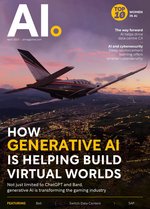Game changer: How AI is powering the future of development

As an integral part of video games since their inception in the 1950s, AI in gaming is nothing new.
Twenty years before the release of Pong by Atari, AI was being used in games. One of the earliest examples is the 1951 mathematical strategy game Nim, in which two players take turns removing objects from piles, where the computer was able to beat human players regularly. In the same year, the AI Ferranti Mark 1 machine at the University of Manchester was used to write a game of chess, in one of the first computer programmes ever written.
Today, generative AI tools have the potential to transform an industry which, according to a report by PwC, is expected to be worth as much as $321 billion by 2026.
Procedural content generation
Highlighted by the rising popularity of tools such as ChatGPT, generative AI has the potential to revolutionise numerous industries, including the video game industry. Video games have already come a long way since their inception, with improved graphics, sound, and gameplay mechanics, but generative AI could take them to the next level.
ne of the most significant ways that generative AI can transform the video game industry is through procedural content generation. Procedural content generation involves using algorithms to generate game content – such as levels, maps, environments, and characters – automatically. This can save game developers a significant amount of time and resources, while also creating a more varied and unique gameplay experience for players.
For the 2020 release of its pioneering flight simulator, Microsoft partnered with the Austrian startup Blackshark.ai, training an AI to generate a photorealistic 3D world from 2D satellite images.
Blackshark’s AI-driven technology enabled Microsoft’s Flight Simulator to display the surface of the entire planet in 3D – with over 1.5 billion photorealistic buildings – giving users an unprecedented immersive 3D flight experience and the largest open world in the history of video games.
With a team of 50+ AI specialists, geospatial engineers, data scientists, and real-time rendering developers, Blackshark developed a unique solution that uses the Microsoft Azure Cloud and AI to gain insights about our planet based on Bing Maps data.
“We have reconstructed approximately 1.5 billion buildings and detected over 30 million square kilometres of vegetation”, explained Stefan Habenschuss, Head of Blackshark’s Machine Learning Group, who described the game as ‘a demonstration of the power of AI’.
“In Flight Simulator, we look at 2D areas and then find footprints of buildings, which is actually a computer vision task,” said Blackshark Co-Founder and CEO Michael Putz, in a recent interview with TechCrunch. “But if a building is obstructed by a shadow of a tree, we actually need machine learning because then it’s not clear anymore what is part of the building and what is not, because of the overlap of the shadow — but then, machine learning completes the remaining part of the building.”
Generative AI is an increasingly popular topic in gaming. Earlier this year, Roblox said it was testing a tool that could accelerate the process of building and altering in-game objects by getting AI to write the code. The tool lets anyone playing Roblox create items such as buildings, terrain, and avatars; change the appearance and behaviour of those things; and give them new interactive properties by typing what they want to achieve in natural language, rather than complex code.
In a blog post, James Gwertzman and Jack Soslow at Venture Capital firm Andreesen Horowitz explained how utilising generative AI will provide substantial benefits for developers.
“When talking to game developers who are experimenting with integrating generative AI into their production pipeline, the greatest excitement is over the dramatic reduction in time and cost,” they write. “One developer has told us that their time to generate concept art for a single image, start to finish, has dropped down from three weeks to a single hour: a 120-to-1 reduction. We believe similar savings will be possible across the entire production pipeline.”
However, despite these cost savings, they say that artists themselves are not in danger of being replaced by AI.
“To be clear, artists are not in danger of being replaced,” they write. “It does mean that artists no longer need to do all the work themselves: they can now set initial creative direction, then hand off much of the time-consuming and technical execution to an AI. In this, they are like cel painters from the early days of hand-drawn animation, in which highly skilled “inkers” drew the outlines of animation, and then armies of lower-cost “painters” would do the time-consuming work of painting the animation cels, filling in the lines.”
Legal issues to be managed
One of the crucial legal issues surrounding generative AI is the ownership of intellectual property rights. The ability of AI systems to create new works without human input raises questions about who owns the rights to these creations, and how to protect them from infringement.
“Although there are present, emerging and potential applications for generative AI as a tool for creatives, some AI generators have been met by confusion and anger from artist communities, due to uncertainty about how generative AI impacts creators’ rights with respect to training data and generated content,” explains Magdalene Bedi, a partner at legal firm Pillar Legal. “For game developers, generative AI poses two core issues: who owns the content generated by AI, and does training data used without the consent of the data owners violate their copyright?
“The first core issue presented by generative AI is that of ownership: who owns the copyright to content produced by generative AI? If ownership isn’t clear, or if content generated by AI is public domain, then game developers will be limited in their ability to protect that content against infringement by others.
“The second core issue presented by generative AI is whether using data to train generative AI models without the data owners’ permission constitutes copyright infringement. Such copyright infringement may occur when training data is input into generative AI models, and in the subsequent content produced by such generative AI models.”
So, although AI promises nothing short of an industry revolution, before these models can be deployed at scale across the gaming sphere, these complex legal hurdles still need to be overcome.







